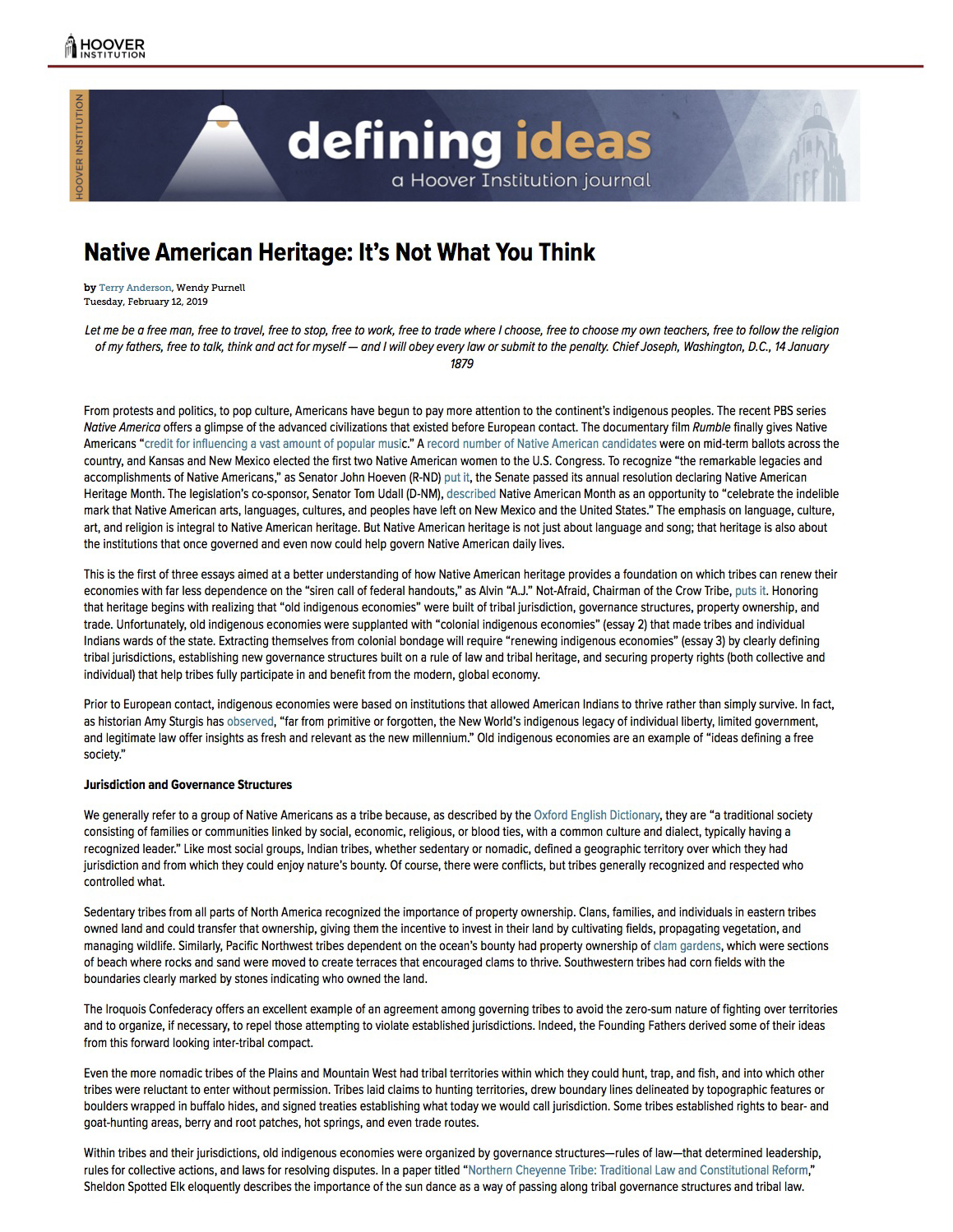Featured Publication
Native American Heritage: It’s Not What You Think
by Terry Anderson
Let me be a free man, free to travel, free to stop, free to work, free to trade where I choose, free to choose my own teachers, free to follow the religion of my fathers, free to talk, think and act for myself — and I will obey every law or submit to the penalty. Chief Joseph, Washington, D.C., 14 January 1879
 From protests and politics, to pop culture, Americans have begun to pay more attention to the continent’s indigenous peoples. The recent PBS series Native America offers a glimpse of the advanced civilizations that existed before European contact. The documentary film Rumble finally gives Native Americans “credit for influencing a vast amount of popular music.” A record number of Native American candidates were on mid-term ballots across the country, and Kansas and New Mexico elected the first two Native American women to the U.S. Congress. To recognize “the remarkable legacies and accomplishments of Native Americans,” as Senator John Hoeven (R-ND) put it, the Senate passed its annual resolution declaring Native American Heritage Month. The legislation’s co-sponsor, Senator Tom Udall (D-NM), described Native American Month as an opportunity to “celebrate the indelible mark that Native American arts, languages, cultures, and peoples have left on New Mexico and the United States.” The emphasis on language, culture, art, and religion is integral to Native American heritage. But Native American heritage is not just about language and song; that heritage is also about the institutions that once governed and even now could help govern Native American daily lives.
From protests and politics, to pop culture, Americans have begun to pay more attention to the continent’s indigenous peoples. The recent PBS series Native America offers a glimpse of the advanced civilizations that existed before European contact. The documentary film Rumble finally gives Native Americans “credit for influencing a vast amount of popular music.” A record number of Native American candidates were on mid-term ballots across the country, and Kansas and New Mexico elected the first two Native American women to the U.S. Congress. To recognize “the remarkable legacies and accomplishments of Native Americans,” as Senator John Hoeven (R-ND) put it, the Senate passed its annual resolution declaring Native American Heritage Month. The legislation’s co-sponsor, Senator Tom Udall (D-NM), described Native American Month as an opportunity to “celebrate the indelible mark that Native American arts, languages, cultures, and peoples have left on New Mexico and the United States.” The emphasis on language, culture, art, and religion is integral to Native American heritage. But Native American heritage is not just about language and song; that heritage is also about the institutions that once governed and even now could help govern Native American daily lives.
This is the first of three essays aimed at a better understanding of how Native American heritage provides a foundation on which tribes can renew their economies with far less dependence on the “siren call of federal handouts,” as Alvin “A.J.” Not-Afraid, Chairman of the Crow Tribe, puts it. Honoring that heritage begins with realizing that “old indigenous economies” were built of tribal jurisdiction, governance structures, property ownership, and trade. Unfortunately, old indigenous economies were supplanted with “colonial indigenous economies” (essay 2) that made tribes and individual Indians wards of the state. Extracting themselves from colonial bondage will require “renewing indigenous economies” (essay 3) by clearly defining tribal jurisdictions, establishing new governance structures built on a rule of law and tribal heritage, and securing property rights (both collective and individual) that help tribes fully participate in and benefit from the modern, global economy.
Prior to European contact, indigenous economies were based on institutions that allowed American Indians to thrive rather than simply survive. In fact, as historian Amy Sturgis has observed, “far from primitive or forgotten, the New World’s indigenous legacy of individual liberty, limited government, and legitimate law offer insights as fresh and relevant as the new millennium.” Old indigenous economies are an example of “ideas defining a free society.”
To read the complete article, click here.
